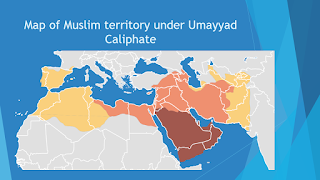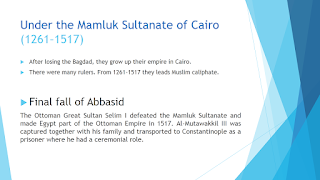The Rise and Fall of The Islamic Caliphate
Caliphate is a glorious past of Muslims, all over the world. Muslim community always needs a rightly guided caliphate. So it's my simple work to remember Our glorious History of caliphate and how we lose that.
- The rise and fall of the Islamic CALIPHATE FROM THE BEGINNING TO THE END
- What is CALIPHATE ?
- Islamic caliphate is a government system based on Islamic sharia law. First caliphate was formed after the death of prophet Muhammad (.)ﷺ The successors of Prophet Muhammad, who was the head of the Islamic state, were called "caliphs," a term translated as "successor“ in English. Starting from the 11th century, various states were established on the lands the Muslims ruled, from the Atlantic Ocean to deep inside China and the authority of the caliph became symbolic in these countries.
- The Rashidun Caliphate (632–661) The Umayyad Caliphate (661–750) The Abbasid Caliphate (750–1258, 1261–1517) The Ottoman Caliphate (1517–1924) A few other states that existed through history have called themselves caliphates, including the Isma'ili Fatimid Caliphate in Northeast Africa (909–1171), the Umayyad Caliphate of Córdoba in Iberia (929–1031), the Berber Almohad Caliphate in Morocco (1121–1269) and the Fula Sokoto Caliphate in present-day northern Nigeria (1804–1903).
- THE BEGINNING
- The Rashidun Caliphate (632–661) الخالفةالراشدة The rightly guided caliphate Creating of Rashidun Caliphate: In the immediate aftermath of the death of Muhammad(,)ﷺ a gathering of Ansar (The helpers) took place to elect the leader of muslim community among themselves. Learning it, Abu Bakr and Umar (Rdiallahanhum) went there and said a hadith of rasulullah that leader might be from Kuraish tribe. After this incident Rashidun Caliphate had been established. Caliphs of Rashidun Caliphate: 1. Abu Bakr رضيهللاعنه 2. Umar رضيهللاعنه 3. Uthman رضيهللاعنه 4. Ali رضيهللاعنه
- The expansion of Rashidun Caliphate Name of CALIPH Border of caliphate Abu Bakr put down rebellions by various Arab tribes after Muhammad died and established the Caliphate as the ruling force in the region. Umar took control of the Middle East including conquering the Sassanids of Iraq. He then took control of many surrounding areas including Egypt, Syria, and North Africa. Uthman continued the conquests that had steadily increased the size of the Islamic empire, but the victories now came at a greater cost and brought less wealth in return. Ali Last caliph of Rashidun caliphate. Kept the control of Muslim territory
- Hazrat Abu Bakr ( هللا رضيعنه )
- After the death of prophet MUHAMMAD (PEACE BE UPON HIM) Abu Bakr was elected as caliph of Muslim ummah. Abu Bakr was near-universally accepted as head of the Muslim community (under the title of Caliph) as a result of Saqifah, though he did face contention as a result of the rushed nature of the event. War against false prophet, as like Musailama Bin Kazzabd and war against disbelievers.
- Second caliph of Rashidun caliphate. Under umar, the caliphate extended at an unprecedented rate, ruling the Sasanian Empire and more than two-thirds of the Byzantine Empire
- Hazrat Uthman (عنه هللا )رضي
- During his rule, Uthman's military style was more autonomical in nature as he delegated much military authority to his trusted kinsmen—e.g., Abdullah ibn Aamir, Muawiyah I and Abdullāh ibn Sa'ad ibn Abī as-Sarâḥ—unlike Umar's more centralized policy. Consequently, this more independent policy allowed more expansion until Sindh, in modern Pakistan, which had not been touched during the tenure of Umar.
- During Hazrat Ali’s ruling there happened the first fitna, a battle among Muslim. He could stop it, but as a result he was martyred.
- Umayyad Caliphate (661–750)
- Rise of Umayyad Caliphate: After the death of Hazrat Ali, Ali's son Hasan was elected as the next caliph, but abdicated in favor of Mu'awiyah a few months later to avoid any conflict within the Muslims. Mu'awiyah became the sixth caliph, establishing the Umayyad Dynasty,[26] named after the great-grandfather of Uthman and Mu'awiyah, Umayya ibn Abd Shams.
- Expansion of Caliphate under Umayyad
- Under the Umayyads, the Caliphate grew rapidly in territory. Incorporating the Caucasus, Transoxiana, Sindh, the Maghreb and most of the Iberian Peninsula(Al- Andalus) into the Muslim world. Area: 5.17 million square miles (13,400,000 km2) The sixth-largest empire ever to exist in history.
- Battle of Karbala and fall of Umayyad Battle of Karbala At the command of Yazid son of Muawiya, an army led by Umar ibn Saad, a commander by the name of Shimr Ibn Thil-Jawshan killed Ali's son Hussein and his family at the Battle of Karbala in 680, solidifying the Shia-Sunni split. There were numerous rebellions against the Umayyads, as well as splits within the Umayyad ranks (notably, the rivalry between Yaman and Qays). And this is the reason for the fall of Umayyads caliphate Fall of Umayyad Supporters of the Banu Hashim and the supporters of the lineage of Ali united to bring down the Umayyads in 750. However, the Shi‘at ‘Alī, "the Party of Ali", were again disappointed when the Abbasid dynasty took power, as the Abbasids were descended from Muhammad's uncle, ‘Abbas ibn ‘Abd al- Muttalib and not from Ali.
- First fall of Abbasid This period of cultural fruition ended in 1258 with the sack of Baghdad by the Mongols under Hulagu Khan. The Abbasid Caliphate had however lost its effective power outside Iraq already by c. 920. By 945, the loss of power became official when the Buyids conquered Baghdad and all of Iraq. The empire fell apart and its parts were ruled for the next century by local dynasties. Abbasid are famous for science and technology. Their time represented a scientific, cultural and religious flowering. Their major city and capital Baghdad began to flourish as a center of knowledge, culture and trade.
- Under the Mamluk Sultanate of Cairo (1261–1517)
- After losing the Bagdad, they grow up their empire in Cairo. There were many rulers. From 1261-1517 they leads Muslim caliphate. Final fall of Abbasid The Ottoman Great Sultan Selim I defeated the Mamluk Sultanate and made Egypt part of the Ottoman Empire in 1517. Al-Mutawakkil III was captured together with his family and transported to Constantinople as a prisoner where he had a ceremonial role.
- The caliphate was claimed by the sultans of the Ottoman Empire beginning with Murad I (reigned 1362 to 1389), while recognising no authority on the part of the Abbasid caliphs of the Mamluk-ruled Cairo. Ottomans are one of the greatest caliphates because of bringing all muslim region under one caliphate. Even there are also many Parallel Regional Caliphates to the Ottomans.
- Abolition of the Caliphate (1924) After the Armistice of Mudros of October 1918 with the military occupation of Constantinople and Treaty of Versailles (1919), the position of the Ottomans was uncertain. The movement to protect or restore the Ottomans gained force after the Treaty of Sèvres (August 1920) which imposed the partitioning of the Ottoman Empire and gave Greece a powerful position in Anatolia, to the distress of the Turks. They called for help and the movement was the result. The movement had collapsed by late 1922. On 3 March 1924, the first President of the Turkish Republic, Mustafa Kemal Atatürk, as part of his reforms, constitutionally abolished the institution of the caliphate.[13] Its powers within Turkey were transferred to the Grand National Assembly of Turkey, the parliament of the newly formed Turkish Republic. The title was then claimed by Hussein bin Ali, Sharif of Mecca and Hejaz, leader of the Arab Revolt, but his kingdom was defeated and annexed by ibn Saud in 1925.
- The Reason behind abolition of Caliphate
- Ottomans push western ideology in their constitution. In example, they legalize LGBT among Muslims which is undoubtedly haram in Islamic Sariah. They employ some young army officer, who were known as ‘Young Turk’. They change Muslim ideology and set western ideology in government. As a result they were able to create a revolt against caliph Abdul Hamid. After Abdul Hamid next caliph was nothing but a puppet. So, just after the first world war, caliphate was destroyed.
- THE END
























Comments
Post a Comment